A Tale of Two Cities Hard to Read


Thomas Carlyle
The French Revolution
Dickens met Scottish writer Thomas Carlyle in 1840 and the two became fast friends. An essayist, satirist, and historian, Carlyle was a tremendous influence on the younger Dickens. Dickens actively sought Carlyle'southward blessing and the influence of Carlyle on Dickens' later work is unmistakable. Although the crusty Carlyle at times dismissed Dickens as merely an entertainer, he truly loved the exuberant, full-of-life writer.
Dickens jokingly claimed to have read Carlyle's The French Revolution (1837) 500 times. He used information technology equally his principal historical reference in writing A Tale of Two Cities, a book which Carlyle called "wonderful" athough complaining that he had to read it by "teaspoonfuls" (Johnson, 1952, p. 955).
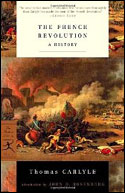
Thomas Carlyle
The French Revolution
Tellson's Bank at Temple Bar
Tellson'south Banking concern, in A Tale of Two Cities, is situated at Temple Bar where the City of London meets the City of Westminster and Fleet Street becomes the Strand. Child & Co bank has operated from this site since the 1660s and Dickens used the bank as a model for Tellson's.
Temple Bar, an archway designed by Christopher Wren, was erected on the spot in 1672, replacing a wooden entrance damaged in the neat fire of 1666. By 1878 Temple Bar had become a impediment to the increasing traffic in the area and was removed to a private residence. It was brought back to the Metropolis of London in 2003 and installed in St. Pauls Churchyard. A monument with a dragon atop marks the spot where Temple Bar stood in Dickens' time.
The Old Men of Tellson's
"Cramped in all kinds of dun cupboards and hutches at Tellson's, the oldest of men carried on the business gravely. When they took a young man into Tellson's London firm, they hid him somewhere till he was old. They kept him in a night identify, like a cheese, until he had the full Tellson season and blue-mould upon him. Then but was he permitted to exist seen, spectacularly poring over large books, and casting his breeches and gaiters into the general weight of the establishment" (A Tale of 2 Cities, p. 50-51).
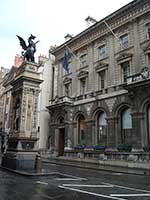
Child and Co Depository financial institution
Site of Tellson'due south Banking company
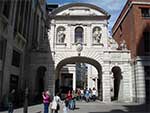
Temple Bar today
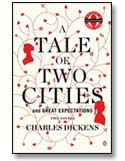
A Date with Dickens
Oprah chooses Charles Dickens' A Tale of Two Cities and Bully Expectations
December 2010

Recalled to Life
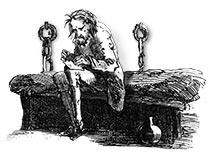
Dr Manette in the Bastille-by Phiz
Beingness "recalled to life" is a major theme throughout A Tale of Ii Cities. In fact, Dickens toyed with the idea of titling the book Recalled to Life.
Dr. Manette's release from the Bastille, Charles Darnay'southward release after the trial for treason, and his later escape from the French prison, are examples of this theme. Also, Roger Cly's fake burial and Jerry Cruncher's nocturnal occupation as a 'resurrection human' follow this theme.
Sydney Carton, on his way to the guillotine, envisions himself 'recalled to life' in the person of the Darnay's future son.
As Carton is contemplating his eminent sacrifice he finds peace in the passage from John 11:25-26:
"I am the resurrection, and the life: he that believeth in me, though he were dead, yet shall he live. And whosoever liveth and believeth in me shall never die" (KJV, John 11: 25-26).
Saint Antoine
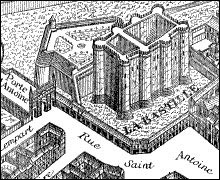
Saint Antoine, where the Defarge's wine shop is located, became function of Paris in 1702. The Bastille prison stood at its western edge.
"A wonderful fact to reflect upon, that every human beast is constituted to be that profound secret and mystery to every other. A solemn consideration, when I enter a great city by night, that every one of those darkly amassed houses encloses its own hole-and-corner; that every room in every one of them encloses its own secret; that every chirapsia centre in the hundreds of thousands of breasts at that place, is, in some of its imaginings, a secret to the center nearest it!" (A Tale of Ii Cities, 1859, p. x)
Ye Olde Cheshire Cheese
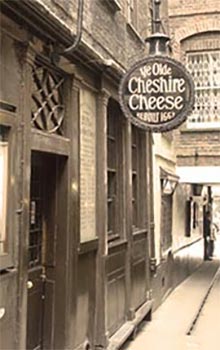
Subsequently Darnay is acquitted of treason he accompanies Sydney Carton "down Ludgate hill to Fleet Street, and then, upwardly a covered mode, into a tavern. Here, they were shown into a little room, where Charles Darnay was soon recruiting his strength with a good plain dinner and good vino" (A Tale of Two Cities, p. 77).
This was almost certainly Ye Olde Cheshire Cheese, rebuilt subsequently the peachy burn of 1666 and a favorite of Dickens.
Read about a visit Ye Olde Cheshire Cheese by Joseph Pennell for Harper's Weekly in November 1887.
Charles-Henri Sanson
 Purple Executioner of French republic
Purple Executioner of French republic
"Sixty-three to-day. We shall mount to a hundred soon. Samson and his men complain sometimes, of being exhausted. Ha, ha, ha! He is so droll, that Samson. Such a Hairdresser!" (A Tale of Two Cities, p. 296)
Charles-Henri Sanson, (xv Feb 1739 - four July 1806) referred to equally Samson in the volume, was the Majestic Executioner of France during the reign of Rex Louis XVI, and High Executioner of the Commencement French republic. He administered death sentence in the city of Paris for over forty years, and past his own hand executed nearly iii,000 people, including the Male monarch himself.
Izaak Walton
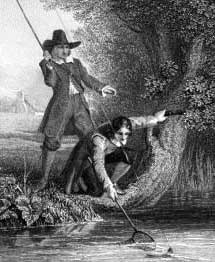
Jerry Cruncher, in his night ruse of "going fishing", is described by Dickens as a deciple of Izaak Walton. Walton's angling bible, The Compleat Angler, was first published in 1653.

Charles Dickens'
A Tale of Two Cities
A Tale of Two Cities - A Story of the French Revolution
A Tale of Two Cities - Published in weekly parts Apr 1859 - November 1859
- Illustrations |
- Locations |
- Plot |
- Characters |
- Shop for the Book |
- Shop for the Video
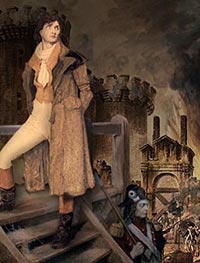
Sydney Carton by Frederick Barnard (1895) over Jean-Paul Houel's Storming of the Bastille (1789).
Charles Dickens' 12th novel was published in his new weekly journal, All the Year Round, without illustrations. Simultaneously with the weekly parts, the novel was also published in monthly parts with illustrations by Hablot Browne. An American edition was also published, in slightly later weekly parts (May to December 1859), in Harper'south Weekly (Patten, 1978, p. 276).
The novel, which begins It was the best of times, information technology was the worst of times, is gear up against the backdrop of the French Revolution and Dickens researched the historical groundwork meticulously, using his friend Thomas Carlyle's History of the French Revolution as a reference (Goldberg, 1972, p. 101). This historical accuracy, with less reliance on character evolution and sense of humour, led to the rather un-Dickensian feel of the book.
Plot
(contains spoilers)
The yr is 1775 and Dr Alexandre Manette, imprisoned unjustly 18 years agone, has been released from the Guardhouse prison in Paris. His daughter, Lucie, who had thought he was dead, and Jarvis Lorry, an amanuensis for Tellson's Bank, which has offices in London and Paris, bring him to England.
Skip ahead five years to 1780. Frenchman Charles Darnay is on trial for treason, accused of passing English secrets to the French and Americans during the American Revolution. He is represented by Stryver and is acquitted when eyewitnesses prove unreliable partly because of Darnay'south resemblance to barrister Sydney Carton.
In the years leading up to the fall of the Bastille in 1789 Darnay, Carton, and Stryver all fall in love with Lucie Manette. Carton, an irresponsible and unambitious graphic symbol who drinks too much, tells Lucie that she has inspired him to think how his life could have been improve and that he would brand any sacrifice for her. Stryver, Carton'southward barrister friend, is persuaded against asking for Lucie's hand by Mr Lorry, at present a close friend to the Manettes. Lucie marries Darnay and they have a girl.
It is a far, far better thing that I do, than I accept always done; it is a far, far meliorate residual that I go to than I take always known.
Meanwhile, in France, Darnay'southward uncle the Marquis St. Evremonde is murdered in his bed for crimes committed against the people. Charles has told Dr. Manette of his human relationship to the French aristocracy, but no one else.
By 1792 the revolution has escalated in France. Mr Lorry receives a alphabetic character at Tellson'due south Banking company addressed to the Marquis St. Evremonde whom no one seems to know. Darnay sees the letter and tells Lorry that he knows the Marquis and volition deliver information technology. The alphabetic character is from a friend, Gabelle, wrongfully imprisoned in Paris and asked the Marquis (Darnay) for aid. Knowing that the trip volition be dangerous, Charles feels compelled to go and help his friend. He leaves for France without telling anyone the real reason.
On the route to Paris, Darnay (St Evremonde) is recognized by the mob and taken to prison in Paris. Mr Lorry, in Paris on business, is joined by Dr. Manette, Lucie, Miss Pross, and later, Sydney Carton.
Dr. Manette has influence over the citizens due to his imprisonment in the Bastille and is able to have Darnay released only he is retaken the next day on a charge by the Defarges and is sentenced to death inside 24 hours.
Sydney Carton has influence on one of the jailers and is able to enter the cell, drug Darnay, exchange dress, and have the jailer remove Darnay, leaving Carton to die in his stead.
On the guillotine Carton peacefully declares "It is a far, far ameliorate thing that I do, than I take ever done; it is a far, far better rest that I go to than I have ever known" (A Tale of Two Cities, 1859, p. 358).
Back to Top ![]()
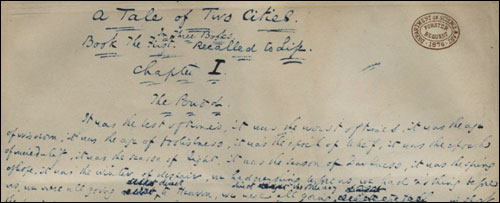
The original manuscript of A Tale of Ii Cities at the Victoria and Albert Museum
Complete List of Characters:
Grapheme descriptions comprise spoilers
| Barsad, John Carton, Sydney Cly, Roger Cruncher, Jerry (Jeremiah) Cruncher, Young Jerry Cruncher, Mrs Darnay, Charles Darnay, Little Lucie Defarge, Ernest Defarge, Madame Thérése St Evrémonde, Marquis de Gabelle, Théophile Gaspard Jacques Joe Lorry, Jarvis Manette, Dr Alexandre Manette, Lucie Mender of Roads Pross, Miss Pross, Soloman Stryver, Mr Tom Vengeance, The | A Tale of 2 Cities Links:The Victorian WebTeaching A Tale of 2 Cities Bartleby.com SparkNotes - First-class! Wikipedia - A Tale of Ii Cities |
Back to Summit ![]()
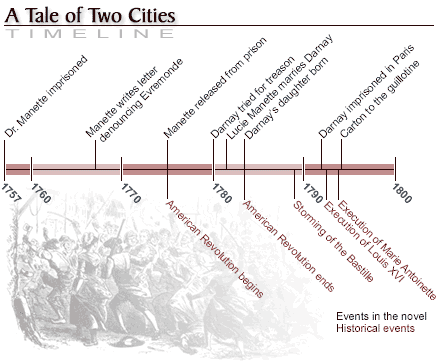
La Guillotine
Although a mechanical device used for beheadings had been in employ for centuries, the guillotine is best known for its use during the Reign of Terror in France during the French Revolution where the device, which takes its name from Dr. Guillotin, was used for thousands of "humane" beheadings. The guillotine was still in use well into the 20th century.
Dickens witnessed a beheading by guillotine in Rome in 1845 which he described in Pictures from Italy:
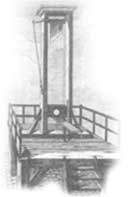
"[The prisoner] immediately kneeled down, below the knife. His neck plumbing equipment into a pigsty, fabricated for the purpose, in a cross plank, was shut down, past another plank in a higher place; exactly similar the pillory. Immediately below him was a leathern bag. And into it his head rolled instantly.
...The eyes were turned upwardly, equally if he had avoided the sight of the leathern bag, and looked to the crucifix. Every tinge and hue of life had left it in that instant. It was irksome, common cold, livid, wax. The torso also.
In that location was a keen deal of blood... A strange appearance was the credible annihilation of the neck. The caput was taken off and so close, that information technology seemed every bit if the knife had narrowly escaped crushing the jaw, or shaving off the ear; and the trunk looked as if there were goose egg left to a higher place the shoulder" (American Notes-Pictures from Italy, p. 391).
Dorsum to Pinnacle ![]()
The Two Cities
Places in the novel
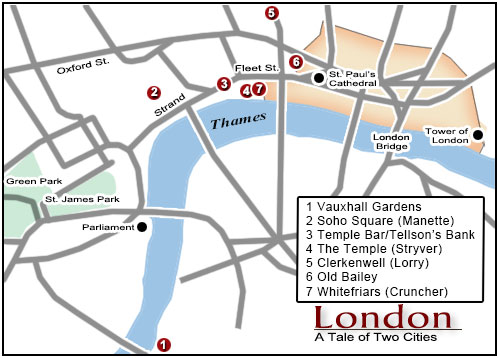
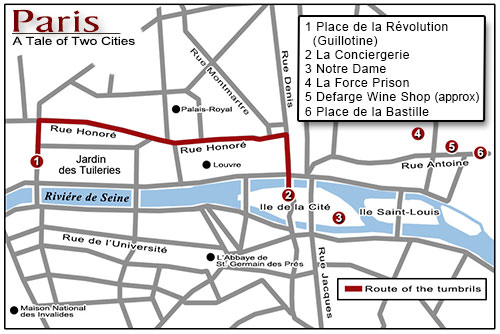
Back to Top ![]()
Resurrection Men
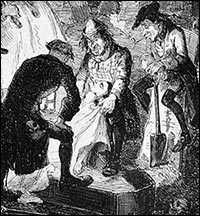
Dickens has Jerry Cruncher, "an honest tradesman" by day, spend his evenings equally a resurrection man, or trunk-snatcher.
By the eighteenth century the demand for fresh corpses for use in medical training had outstripped the supply, which could only legally be obtained from executed murderers. The dread of autopsy afterward execution being considered an additional deterrent for would-be murderers.
To supply this demand for fresh corpses surgeons and anatomists turned to resurrection men or torso snatchers. Strange bedfellows indeed!
Ruth Richardson, in her book Death, Dissection, and the Destitute described a common method these men used to obtain fresh corpses:
"Bodysnatchers invariably worked in modest gangs, to permit at least 1 person to be on the look-out for potential danger. Freshly-filled graves meant that in general the digging was easy, equally the earth was still loose, and not nevertheless compacted by settling. Canvas would sometimes be laid by the grave to receive the displaced earth, then as to leave none on surrounding turf. A hole would be dug at the head of the grave, down to the coffin, and hooks or a crow-bar inserted under the chapeau. The weight of earth on the rest of the lid acted as a counter-weight, so that when force per unit area was exerted the lid invariably snapped across and the body could exist hoisted out of the grave with ropes. Sacking would be heaped over the chapeau beforehand to deaden the sound of slap-up wood. At this stage in the proceedings, the corpse should in principle have been stripped and the grave-clothes thrown back, before the earth was shoved back into identify, and the body trussed upwardly neck and heels in a sack" (Richardson, 1987, p. 59).
It is interesting to notation that a corpse was not considered to be property thus the stealing of a corpse was merely a misdemeanor. That was the reason that the grave-clothes, and any other articles virtually the corpse were thrown back in the grave, the taking of which would exist considered a felony.
Cases arose in the early nineteenth century of surgeons buying fresh corpses whom they doubtless knew had been murdered for the purpose.
Parliament, seeking an end to this heinous practise, passed the Anatomy Act of 1832. Under this law the bodies of unclaimed expressionless from workhouses could exist used for dissection. The reaction to this practice was widespread insurgence in the workhouses every bit what was viewed as a punishment to murder was now considered a judgement on the poor.
Dorsum to Top ![]()
- Sketches by Boz |
- Pickwick |
- Oliver Twist |
- Nickleby |
- Old Curiosity Store |
- Barnaby Rudge |
- Chuzzlewit |
- Christmas Carol |
- Christmas Books |
- American Notes |
- Pictures from Italy |
- Dombey and Son |
- Copperfield |
- Dour House |
- Hard Times |
- Little Dorrit |
- Tale of Two Cities |
- Smashing Expectations |
- Our Common Friend |
- Edwin Drood |
- Small Works |
- The Uncommercial Traveller |
- Brusk Stories
Affiliate Links Disclosure
The Charles Dickens Folio is a member of affiliate programs at Amazon and Zazzle. This means that there are links that take users to sites where products that we recommend are offered for sale. If purchases are made on these sites The Charles Dickens Folio receives a small commission.
Source: https://www.charlesdickenspage.com/charles-dickens-a-tale-of-two-cities.html
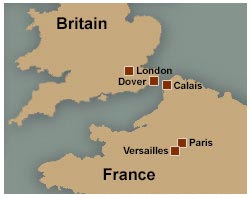
0 Response to "A Tale of Two Cities Hard to Read"
Post a Comment